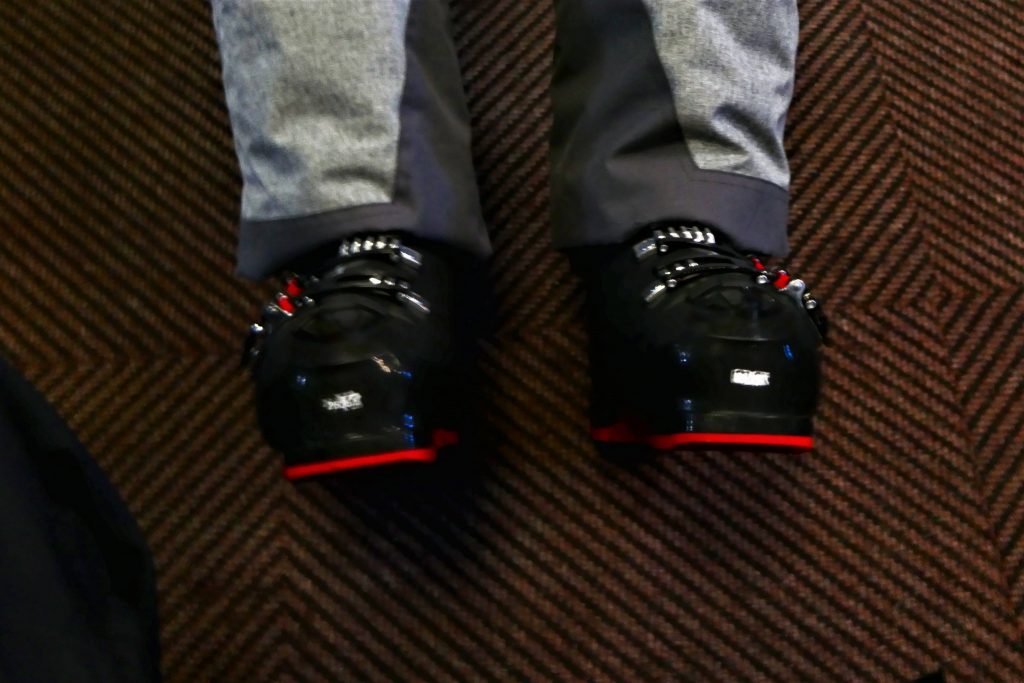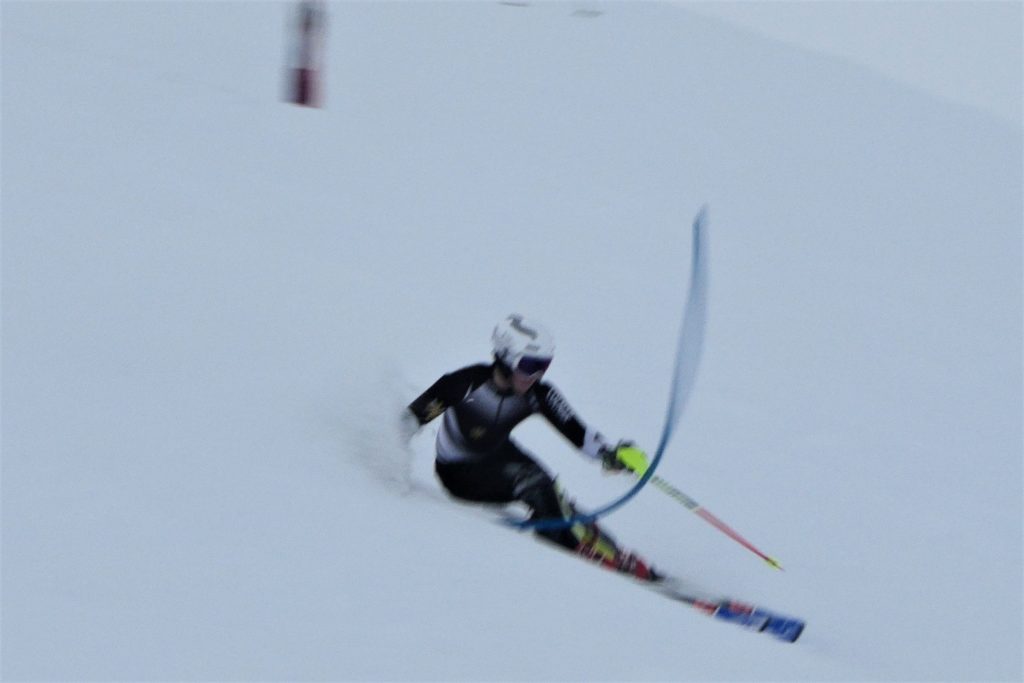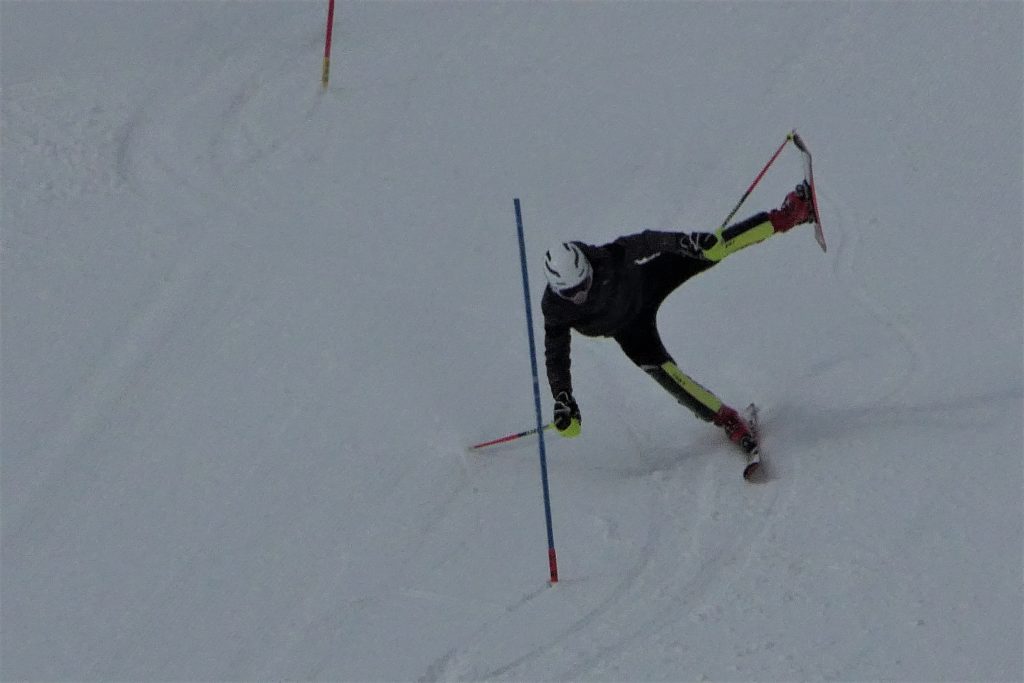
Alignment
The boot photograph shows how far off Gui’s alignment is. Available adjustment on the boot cuffs was very limited. However – plastic wedges can be placed inside the the boots – between the shell and the liner at the cuffs to alter the effective angle of the boot shaft. To get more edging place the wedges at the inside of the lower legs – until the boot soles are perpendicular to the legs. This can be done with improvised materials.
When checking alignment the skier must be sitting with the hips flexed below the pelvis – the lower back straight – the feet vertical and hip width apart. The legs must be locked out straight to see the real bone morphology.
Shops use machinery for canting and link this with provision of custom foot-beds. However those issues are actually not related. Using the method given above it’s easy to prove that there is no difference whatsoever with foot-beds in or out of the boots – the bone structure alignment remains the same – so weight bearing foot-beds are a totally separate issue and correct cuff alignment (to the leg bone structure) cannot be guaranteed when standing on a machine.

Hip Angulation
Protecting the lumbar spine is critical when developing hip angulation. During short turns the outside ski (usually) comes around beneath the inside ski – especially when the skis are close together or hip width apart. The body however must avoid rotation so that the skier doesn’t go into an uncontrollable spin and also so as to be able to manipulate the centre of mass trajectory more to his/her advantage. Preventing the body from rotating as the outside ski comes around causes the outside hip to be pulled around in front of the rib cage. The hip must be prevented from doing this so as to keep the lower abdominal postural reflex active. Pull back the outside hip from the turn initiation through to the completion.
We do not “face downhill” with the shoulders/chest – it’s with the pelvis! In very short turns this distinction is hard to see – but just avoid the supporting hip begin brought forward beneath the front ribs.
Control of Rotation
“Rotation” as a problem in skiing is referring to twisting the body in the direction of the turn. There is shoulder rotation, hip rotation and whole body rotation. I guess you could count twisting of the feet but that’s not referred to as rotation. Angulation is the antidote to rotation!

Forward pressure
During a turn angulation (combined with inclination) is what permits safe forward pressure on the ski fronts – because if you are ejected over the ski fronts you just make it into another turn!
Carving
We used angulation for introducing carving at low speed. Skis wide apart for a support base and the angulation creating “edging” without moving the centre of mass. With higher speeds the edging is managed through inclination (the upside down pendulum) – with motion of the centre of mass.
When changing direction the skis travelling across the hill go through a flat phase called “neutral” as the skier crosses over to change edges. During this transition there can be a slight counter rotation of the pelvis to create early angulation if the turn is long. This is a good exercise also for elimination of unnecessary rotation. However it’s not necessary to always counter rotate anything at the turn initiation – the “foot forward” exercise (video clip) still to be discussed shows a good turn transition type of action from a “facing downhill” position maintained from start to finish – just preventing hip rotation towards the end.
Side Slipping
We use the centre of mass (CoM) to initiate side slipping and to stop it – moving the CoM downhill slightly to start and back uphill to stop. Using the CoM as a sort of joy stick control will generate a forward or backward diagonal side slip. The skis have to be close together so as to stay on their uphill edges and this is preparation for learning to pivot. Side slipping skills are important for navigating difficult steep narrow slopes where turning is unsafe.
Pivot
There’s a link here to pivot demonstrations and explanations
Use the balls of the feet.
Use a strong pole plant – for guiding the centre of mass and keeping pressure on the ski.
This is “fall-line” skiing – always on uphill “braking” edges with the skis swinging into the turn laterally – from uphill edges.
Avoid rotation or twisting – move the centre of mass linearly aimed between the ski tips and the pole plant.
Pole Plant / Pole Touch
With dynamic skiing – with forward momentum – the skis provide all the support and control of the centre of mass trajectory – so only a “pole touch” is used downhill (with a wrist movement) as the body crosses over the skis into the new turn.
Foot Forward
Pushing the foot through the arc from behind the body to below – in front of the body – is how to activate a tighter turn – especially when using dynamics. It’s often referred to as “working the ski”. This is especially useful on very steep terrain as it successfully controls speed without resorting to outright braking and skidding.

